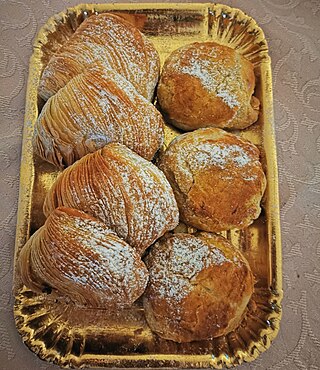Top Qs
Timeline
Chat
Perspective
Sfogliatella
Italian filled pastry From Wikipedia, the free encyclopedia
Remove ads
Sfogliatella (Italian: [sfoʎʎaˈtɛlla]; pl.: sfogliatelle; Neapolitan: sfugliatella [ʃfuʝʝaˈtɛllə], pl. sfugliatelle), often conflated with a similar pastry known as a lobster tail, is a shell-shaped pastry with a sweet or creamy filling, originating in the Campania region of Italy.[2][3] Sfogliatella means 'small, thin leaf/layer', as the pastry's texture resembles stacked leaves.[citation needed]
Sfogliatella Santa Rosa, from which the current sfogliatella was born, was created in the monastery of Santa Rosa in Conca dei Marini, Campania, in the 17th century. Pasquale Pintauro, a pastry chef from Naples, acquired the original recipe and began selling the pastries in his shop in 1818.[4]
In Neapolitan cuisine, there are two types of the pastry: sfogliatella riccia ('curly'), the standard version,[5] and sfogliatella frolla, a less labour-intensive pastry that uses a shortcrust dough and does not form the sfogliatella's characteristic layers. Neither are frequently made at home, instead being generally purchased from pasticceria.[1]
A variation named coda d'aragosta (in the United States, "lobstertail") also exists, with the same crust but a sweeter filling.[6]
Remove ads
Gallery
- Sfogliatelle Santa Rosa
- On sale in Rome
- Whole and interior
See also
References
External links
Wikiwand - on
Seamless Wikipedia browsing. On steroids.
Remove ads




